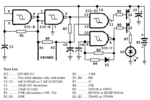Alistair Ballantyne
Junior Member level 2
I made this simple water tester circuit from the Electronics for Dummies book.
Three issues –
The circuit works but only without the resistor (R2) between base and emitter. Put this in and the circuit fails. Why? I don’t understand. Is there something wrong with my wiring?
Given the current will flow through the path of least resistance doesn’t that mean I have 8.3v (9vcc – 0.7v VBE) going into the base – and wont that damage the transistor?
Is the resulting hFE not so large as to damage the LED?
Or should I be looking at the entire circuit and calculating current at base as 0.013A?
(9v VCC - 2v LED - 0.7v BE) / 470Ω = 0.013A.
Appreciate any help.
Thank you.


Three issues –
The circuit works but only without the resistor (R2) between base and emitter. Put this in and the circuit fails. Why? I don’t understand. Is there something wrong with my wiring?
Given the current will flow through the path of least resistance doesn’t that mean I have 8.3v (9vcc – 0.7v VBE) going into the base – and wont that damage the transistor?
Is the resulting hFE not so large as to damage the LED?
Or should I be looking at the entire circuit and calculating current at base as 0.013A?
(9v VCC - 2v LED - 0.7v BE) / 470Ω = 0.013A.
Appreciate any help.
Thank you.
